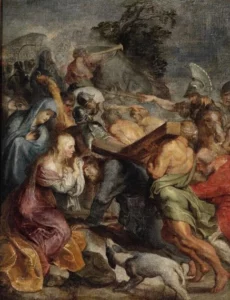Via Dolorosa by Peter Paul Rubens
Using the imagination in an active way was a technique developed by Carl Jung. He describes how he entered into a dialogue with different parts of himself that live in the unconscious. It was a technique that nearly drove him to insanity, and he had to find ways to recentre himself through the strength of his ego. It sounds as if it is a bit like dreaming while you are awake and conscious, but allowing images to rise up from the depths, and then interacting with them. The images are in fact symbols, representing deep interior parts of ourselves.
Looking at this from a spiritual perspective, it is clear that if we pray to Jesus Christ and envisage him, that is, in effect, using our active imagination to develop a relationship with this central and archetypal figure within our psyche: Jesus Christ as both an inner presence and a symbol of divinity – both immanent and transcendent. The method of Ignatian spirituality directly encourages speaking directly to God, and actively using the imagination to picture scenes from the bible and encounters with Christ, and being part of the scene or the story.
In a lecture, Jung actually commented on the use of guided imagery in the Greater Exercises of Saint Ignatius of Loyola, and took as one example the scene of the way to the crucifixion – the Via Dolorosa. Using that scene, the participant in the Ignatian exercises is encouraged to be there in their imagination by evoking the smells, colours, the jeering crowds – the dust, sweat, blood and tears. You are encouraged to feel the sharp stones under your feet and the hot sun as you move with the crowd to Golgotha, carrying the weight of your cross. Using the imagination in this way the events of Christ’s life can become so vivid that they become actual and immediate experience.
The Jungian Robert A. Johnson, who has appeared before in these posts, thought that this was fine if it truly served one’s religious purpose, and he saw it as primarily geared to ‘the medieval mentality, but much of that mentality still lives in us and we can honour it.’ But Jung said it would be better for us if we could walk, using our active imagination, on our own Via Dolorosa, and find out what there is in our individual selves, and the srosses we carry. In this way it wouldn’t be prescriptive based on authority or tradition, but rather a response to the reality of what lives inside us. As Johnson comments:
‘Of one thing you can be sure: Ultimately every road is a Via Dolorosa, for it leads us into the issues and conflicts that every person must pass through, sometimes painfully and with heroic spirit, sometimes with sacrifice, in order to be initiated into the realm of consciousness. If you have a modern mentality, you must find your own path. Go your own way, which is both terrifying and exhilarating. No one can tell you any longer the way, because there is no longer one prescribed way, but only a way – your way, which is as valid as any other as long as you live it honestly. …
No one else can tell us which final direction it should take, and no one else can walk it for us.’
